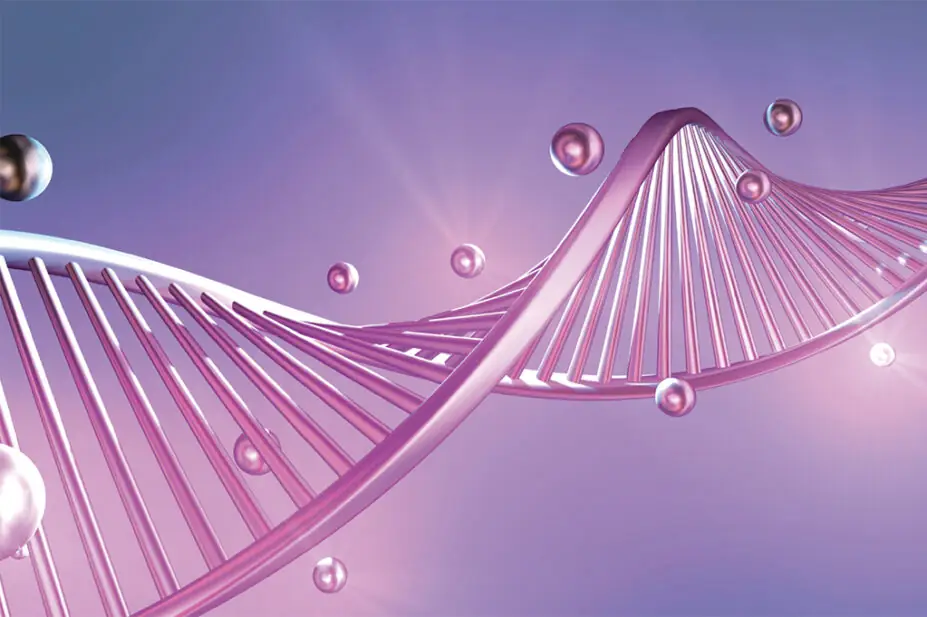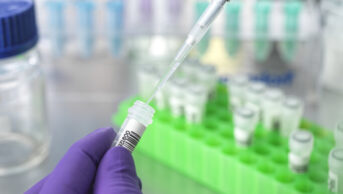
ORLA/DREAMSTIME.COM
In the current era of genomics, which carries the promise of personalised medicine, interest is also growing in the epigenome and how your DnA might not necessarily be your destiny.
So what is epigenetics? the Hongerwinter (hunger winter) of 1944 in Nazi-occupied Netherlands affected over 4 million people. It was ascribed to a combination of Nazi revenge for the reluctance of the Dutch people to aid the Axis war efforts and an unusually harsh winter: humankind and nature joined forces to inflict immense suffering.
Among such darkness, the experiences of the Dutch famine offered science some potentially priceless observations. As well as corroborating the idea that intake of dietary gluten was linked to the presentation of coeliac disease1, scientific investigations of famine survivors and their offspring gave rise to the idea that preconceptual exposure to famine may have the ability to imprint on the genes of offspring2. Thus the legacy of the Dutch famine, which led to the death of thousands, may have also touched the lives of future generations, too. the science of epigenetics was born.
Your destiny
The idea that your DNA, the fundamental building blocks of life, may not necessarily be your destiny is not a new one. the French biologist Jean-Baptiste Lamarck (1744–1829) coined the notion of soft inheritance as an alternative to Darwinism.
Lamarck, or rather Lamarckism, became synonymous with the idea that an organism can pass on to its offspring characteristics that it acquired during its lifetime. In short environment, however this is taken to mean, might be able to leave its mark on the genome.
The genome represents the sum total of a person’s biological data derived from their parents, encoded as DNA (and RNA), the instructions for building all the proteins required to make us who we are. Along the way we pick up mutations in that genomic instruction manual represented as single nucleotide polymorphisms and other changes such as copy number variations as a consequence of things like our parents’ age at conception and other factors3. Indeed, the analysis of such mutations and their link to health predominates modern-day genetics research.
Science now realises, however, that over and above our DNA instruction manual, there resides another layer: the epigenome. This consists of a series of chemical compounds that have the ability to modify the function of the genome in providing instructions eventually leading to switching genes on and off. The epigenome works in several ways, primarily including:
- DNA methylation
Attaching methyl groups to the backbone of DNA makes it possible to switch genes on or off. Methyl groups, for example, donated by Sadenosylmethionine, part of the methionine-homocysteine pathway and intersecting one-carbon metabolism, adhere to cytosine in CpG dinucleotides via various DNA methyltransferases. Methylation of CpG islands in the promoter region of a gene inhibit the expression of that gene.
- Histone modification
It has been estimated that each diploid cell contains about two metres of DNA4. That is a lot of DNA to fit into a cell nucleus. In order to accomplish such a feat, chromosomal DNA is compacted and packaged up by a group of special proteins called histones to form a chromatin complex. Different charges keep the relationship between DNA and histones tight. Histones can be covalently modified (post-translational modification) at their tails in a variety of ways that subsequently alter their hold on the packaged DNA and, indirectly, what genes can be switched on or off. The various chemical modifications relevant to histones — methylation, acetylation, phosphorylation — make up the histone code, a growing combination of histone modifications5.
Identical twins are not identical
Despite sharing identical genomes, even identical (monozygotic) twins can be viewed as different in epigenomic terms6,7. Various twin studies have shown discordance for disease and risk of disease thought to be due to epigenetic differences, ranging from childhood leukemia to primary biliary cirrhosis8,9. Although environmental variables and exposure patterns may play a role in differential disease patterns in twins, there is an increasing feeling that epigenomic differences, even beginning in utero, may also show involvement.
If we recognise the malleability of the epigenome, our questions then turn to what factors could potentially cause such epigenetic changes and the evidence for their potential relationship to health and disease. Within this context, lifestyle choices and environmental exposures represent modifiable variables potentially affecting the expression of DNA.
Diet, pollutants and lifestyle
Diet is a key factor in epigenomics. Godfrey and colleagues suggested a relationship between a maternal low carbohydrate diet and subsequent gene methylation related to subsequent offspring weight gain10. Perhaps even more surprising is the suggestion that paternal diet may also have the ability to influence offspring epigenomic reprogramming, at least in the mouse model11. Other environmental factors also may have a bearing on the epigenome. Tobacco smoking represents one factor known to influence DNA methylation patterns. Breitling and colleagues reported on altered methylation patterns for a gene of potential cardiovascular drug target interest in smokers compared with former smokers and non-smokers12. Flom and colleagues detailed a similar link between prenatal tobacco smoke exposure and DNA methylation issues in adulthood13. Other environmental pollutants have similarly been reported to modify epigenetic markers, including airborne particulates, metals and various persistent organic pollutants14.
Perhaps even more surprising is the suggestion that societal influences may also impact on the epigenome. McGuinness and colleagues reported an association between socioeconomic status and DNA methylation, citing hypomethylation as being linked to job type alongside various markers of inflammation15. Assuming such an association is replicated, there are profound implications for Government policy and society, especially in the current climate of austerity.
Epigenetic medicines
With the ever increasing research focus on the epigenome, thoughts are also turning to the possibility of pharmaceutical epigenetic modification as a therapeutic option for various conditions. Certain types of cancer have long been suspected to include an epigenetic element following the findings of hypermethylation of promoter regions of tumour-suppressing genes, in effect silencing such genes16. Various areas of drug development are progressing, including:
- Histone deacetylase inhibitors
A balance between acetylation and deacetylation of lysine residues in histone tails is required for normal cell function. Altered functioning of histone deacetylases (HDACs) and histone acetyltransferases has been reported in various cancers and other conditions17. HDAC inhibitors, therefore, represent a potential therapeutic strategy. Indeed, one of the most famous antiepileptic medicines, valproic acid, is a potent HDAC inhibitor and is finding a new role in this brave new epigenomic world18. Other HDAC inhibitor formulations include vorinostat (Zolinza, Merck & Co) used for the cutaneous manifestations of T-cell lymphoma.
- DNA methyltransferase inhibitors
DNA methyltransferases represent potential therapeutic targets in conditions of hypermethylation19. Several formulations categorised as DNA methyltransferase inhibitors have been trialled, including azacytidine (Vidaza, Celgene) and decitabine (Dacogen, Astex Pharmaceuticals), both indicated for myelodysplastic syndromes.
The future of the epigenome
There is little doubt that the study of the epigenome is fast becoming an integral part of the way science views health and disease, intersecting both genetic and environmental influences. Where once genes were seen as immutable and a fixed roadmap to our predisposition to health or ill health, the ability to modify the function of the genome adds a distinctive layer to proceedings. By understanding such modifications, a wide array of possibilities are open for drug development and managing diseases and their risk. Indeed, the notion that the environment may have a significant effect on the epigenome carries important considerations on the various policies for the promotion of a healthy lifestyle.
Kalliopi Dodou is senior lecturer in pharmaceutics, Sunderland Pharmacy School, University of Sunderland;
Paul Whiteley is a researcher based in the North-East of England.
- 1.van Berge-Henegouwen GP, Mulder CJ. Pioneer in the gluten free diet: Willem-Karel Dicke 1905-1962, over 50 years of gluten free diet. Gut. 1993;34(11):1473-1475. doi:10.1136/gut.34.11.1473
- 2.Heijmans BT, Tobi EW, Stein AD, et al. Persistent epigenetic differences associated with prenatal exposure to famine in humans. Proc Natl Acad Sci USA. 2008;105(44):17046-17049. doi:10.1073/pnas.0806560105
- 3.Kong A, Frigge ML, Masson G, et al. Rate of de novo mutations and the importance of father’s age to disease risk. Nature. 2012;488(7412):471-475. doi:10.1038/nature11396
- 4.Annunziato AT. DNA Packaging: Nucleosomes and Chromatin. Nat Educ. 2008;1(1):26. https://www.nature.com/scitable/topicpage/dna-packaging-nucleosomes-and-chromatin-310/
- 5.Jenuwein T, Allis CD. Translating the Histone Code. Science. 2001;293(5532):1074-1080. doi:10.1126/science.1063127
- 6.Haque FN, Gottesman II, Wong AHC. Not really identical: Epigenetic differences in monozygotic twins and implications for twin studies in psychiatry. American J of Med Genetics Pt C. 2009;151C(2):136-141. doi:10.1002/ajmg.c.30206
- 7.Czyz W, Morahan JM, Ebers GC, Ramagopalan SV. Genetic, environmental and stochastic factors in monozygotic twin discordance with a focus on epigenetic differences. BMC Med. 2012;10(1). doi:10.1186/1741-7015-10-93
- 8.Galetzka D, Hansmann T, El Hajj N, et al. Monozygotic twins discordant for constitutiveBRCA1promoter methylation, childhood cancer and secondary cancer. Epigenetics. 2012;7(1):47-54. doi:10.4161/epi.7.1.18814
- 9.Selmi C, Mayo MJ, Bach N, et al. Primary biliary cirrhosis in monozygotic and dizygotic twins: Genetics, epigenetics, and environment. Gastroenterology. 2004;127(2):485-492. doi:10.1053/j.gastro.2004.05.005
- 10.Godfrey KM, Sheppard A, Gluckman PD, et al. Epigenetic Gene Promoter Methylation at Birth Is Associated With Child’s Later Adiposity. Diabetes. 2011;60(5):1528-1534. doi:10.2337/db10-0979
- 11.Carone BR, Fauquier L, Habib N, et al. Paternally Induced Transgenerational Environmental Reprogramming of Metabolic Gene Expression in Mammals. Cell. 2010;143(7):1084-1096. doi:10.1016/j.cell.2010.12.008
- 12.Breitling LP, Yang R, Korn B, Burwinkel B, Brenner H. Tobacco-Smoking-Related Differential DNA Methylation: 27K Discovery and Replication. The American Journal of Human Genetics. 2011;88(4):450-457. doi:10.1016/j.ajhg.2011.03.003
- 13.Flom J, Ferris J, Gonzalez K, Santella R, Terry M. Prenatal Tobacco Smoke Exposure and Genomewide Methylation in Adulthood. Cancer Epidemiology, Biomarkers & Prevention. 2011;20(4):720-720. doi:10.1158/1055-9965.epi-11-0097
- 14.Baccarelli A, Bollati V. Epigenetics and environmental chemicals. Current Opinion in Pediatrics. 2009;21(2):243-251. doi:10.1097/mop.0b013e32832925cc
- 15.McGuinness D, McGlynn LM, Johnson PC, et al. Socio-economic status is associated with epigenetic differences in the pSoBid cohort. Int J Epidemiol. 2012;41(1):151-160. doi:10.1093/ije/dyr215
- 16.Jones PA, Laird PW. Cancer-epigenetics comes of age. Nat Genet. 1999;21(2):163-167. doi:10.1038/5947
- 17.Glozak MA, Seto E. Histone deacetylases and cancer. Oncogene. 2007;26(37):5420-5432. doi:10.1038/sj.onc.1210610
- 18.Gottlicher M. Valproic acid defines a novel class of HDAC inhibitors inducing differentiation of transformed cells. The EMBO Journal. 2001;20(24):6969-6978. doi:10.1093/emboj/20.24.6969
- 19.Lyko F, Brown R. DNA Methyltransferase Inhibitors and the Development of Epigenetic Cancer Therapies. JNCI: Journal of the National Cancer Institute. 2005;97(20):1498-1506. doi:10.1093/jnci/dji311


